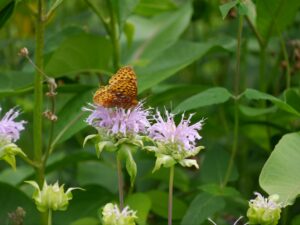The following article appeared in the inaugural issue of The Sentinel, a new newspaper serving Highstead’s hometown of Redding, CT.

Spring has sprung in Redding. Choruses of spring peepers are heralding the arrival of spring from every swamp and vernal pool. Woodcock mating calls, spring bulbs poking through the soil, the return of migrating songbirds, and longer daylight hours all renew our hope of warmer weather on the horizon. But with it comes summer chores and chief among them is mowing the lawn. I’m not sure about you, but I can think of much better ways to spend my weekends than pushing a loud, smoky lawnmower around the yard and spending my hard-earned money on Weed & Feed to spread on the lawn.
Twenty percent of Connecticut is covered with lawn, putting it near the top of the list of states with the most turfgrass. As a nation we have come to embrace the beauty of neatly trimmed expanses of green surrounding our home and workplaces. Once a blade of grass stretches itself above the rest, we mow it. When a “weed” gets established, we spray it. But do we really need to run for the Roundup and 2,4-D every time a dandelion raises its golden rays above the grass or a patch of clover starts to interrupt the order of our neatly groomed blades of grass? Are weeds really our enemy?
In the past five years a shift in values has started to take place in Connecticut. Homeowners who once prioritized a neatly manicured and weed-free lawn have decided that using their yards to support pollinators is a higher priority. All across Connecticut and the Northeast people are joining a Pollinator Pathway to help increase habitat for butterflies, bees, and other pollinators. They are committed to rethinking their lawns, planting native plants, and avoiding pesticides.
What does it mean to rethink your lawncare? Not everyone is able to convert their lawn to a wildflower meadow but by adjusting your lawncare practices you can transform your lawn into a valuable pollinator habitat. One of the easiest actions to take is to mow less and reduce chemical use. Research shows that mowing your lawn every 2-3 weeks instead of every week significantly increases the number of flowers and abundance of bees.
Pollinators need your weeds. One good example is the Great Spangled Fritillary butterfly. The common lawn violet is the exclusive food for its caterpillars. The adult female lays her eggs near violets in the fall, they quickly hatch and overwinter as caterpillars, and as soon as they awaken in the spring they need to feed on violets to grow into butterflies. White clover is another a common lawn weed that is very difficult to eradicate. Although it is not native, its leaves are food for many species of butterflies and the flowers produce nectar that support native bees, honey bees, moths, and butterflies.
Allowing some weeds to coexist with your grass and letting them get tall enough to flower will turn your sterile lawn into a vibrant home for bees and butterflies. If this seems radical, start with a portion of your lawn – maybe the edges, a corner, or just the backyard. An alternative starting point is to change your mower height to 4” instead of 2.5”. This will allow some flowers to persist below the cut line.
This spring, as the days warm and the grass starts to grow, give yourself permission to leave the lawnmower in the shed and enjoy a real day off. Lounge in the hammock, listen to the soft buzz of the bees and watch the butterflies float in the wind. They will appreciate it as much as you.